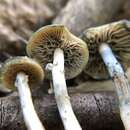mk
имиња во трошки


Psilocybe ovoideocystidiata is a psilocybin mushroom, having psilocybin and/or psilocin as main active compounds. It is closely related to P. subaeruginascens from Java, P. septentrionalis from Japan, and P. wayanadensis from India. This mushroom was first documented by Richard V. Gaines in Montgomery County, Pennsylvania in June 2003. Although it is sometimes confused with Psilocybe caerulipes, it can be distinguished by its rhomboid spores, larger stature, earlier fruiting season and membranous annulus.
From the abundant ovoid pleurocystidia and cheilocystidia.
Psilocybe ovoideocystidiata is mainly native to the eastern United States, in a range that stretches from Kentucky to Rhode Island, but has been found as far south as Mississippi. It is particularly common in the Ohio river valley. Here, it is often found along rivers and streams, usually in the woody debris of overflow areas, in man-made mulch and wood chips, and is sometimes found alongside of Japanese knotweed. It also tends to prefer shady areas and avoid direct sunlight. More recently, it has turned up in the western United States, in the Pacific States from Western Washington to Southern California, though it is still a relatively uncommon species in this region. A relatively recently identified species, there is evidence that its range is currently undergoing rapid expansion, and it is frequently reported to appear in new areas.
This mushroom is typically gregarious, growing in groups of several hundred individuals in one particular area, as well as in multiple small clusters of several mushrooms each, within close proximity of one another. Solitary specimens also occur on occasion.
Seasonality varies a great deal depending on what region they are found in, but in the northeastern US, they are most common in the spring, from mid-April to late-June (peaking late-May), especially after periods of steady heavy rain for several consecutive days (a common weather pattern in the eastern US during spring). However, they may occasionally fruit as late as November. These mushrooms seem to be very sensitive to the season and fruit chiefly in the spring; very little fruiting occurs during other times of year, even during favorable weather condition. [2]
 Psilocybe ovoideocystidiata spores
Psilocybe ovoideocystidiata spores Psilocybe ovoideocystidiata is a psilocybin mushroom, having psilocybin and/or psilocin as main active compounds. It is closely related to P. subaeruginascens from Java, P. septentrionalis from Japan, and P. wayanadensis from India. This mushroom was first documented by Richard V. Gaines in Montgomery County, Pennsylvania in June 2003. Although it is sometimes confused with Psilocybe caerulipes, it can be distinguished by its rhomboid spores, larger stature, earlier fruiting season and membranous annulus.
Psilocybe ovoideocystidiata es una especie de setas de psilocibina de la sección Stuntzae, que tiene psilocibina y/o psilocina como principales compuestos activos. Está estrechamente relacionado con P. subaeruginascens de Java, P. septentrionalis de Japón y P. wayanadensis de la India. Este hongo fue documentado por primera vez por Richard V. Gaines en el condado de Montgomery, Pensilvania, en junio de 2003. Aunque a veces se confunde con Psilocybe caerulipes, se puede distinguir por sus esporas romboides, su mayor tamaño, su época de fructificación más temprana y su anillo membranoso.
ovoideocystidiata se refiere a los pleurocistidios y queilocistidios ovoides.
Psilocybe ovoideocystidiata es originaria principalmente del este de Estados Unidos, en un área de distribución que se extiende desde Kentucky hasta Rhode Island, pero se ha encontrado hasta el sur de Mississippi. Es especialmente común en el valle del río Ohio. Aquí se encuentra a menudo a lo largo de los ríos y arroyos, normalmente en los restos leñosos de las zonas de desbordamiento, en el mantillo hecho por el hombre y en las virutas de madera, y a veces se encuentra junto al knotweed japonés. También suele preferir las zonas de sombra y evitar la luz solar directa. Más recientemente, ha aparecido en el oeste de Estados Unidos, en los Estados del Pacífico desde el oeste de Washington hasta el sur de California, aunque sigue siendo una especie relativamente poco común en esta región. También se ha registrado en Europa, concretamente en Suiza y el sur de Alemania. Se trata de una especie de identificación relativamente reciente, pero hay indicios de que su área de distribución se está extendiendo con rapidez y está apareciendo en nuevas zonas.
Esta seta es típicamente gregaria, creciendo en grupos de varios cientos de individuos en una zona concreta, así como en múltiples grupos pequeños de varias setas cada uno, muy cerca unos de otros. En ocasiones también se dan ejemplares solitarios.
La estacionalidad varía mucho según la región en la que se encuentren, pero en el noreste de EE.UU. son más comunes en primavera, desde mediados de abril hasta finales de junio (con un pico a finales de mayo), especialmente después de periodos de lluvia durante varios días consecutivos (un patrón climático común en el este de EE.UU. durante la primavera). Sin embargo, ocasionalmente pueden fructificar hasta noviembre.
Psilocybe ovoideocystidiata es una especie de setas de psilocibina de la sección Stuntzae, que tiene psilocibina y/o psilocina como principales compuestos activos. Está estrechamente relacionado con P. subaeruginascens de Java, P. septentrionalis de Japón y P. wayanadensis de la India. Este hongo fue documentado por primera vez por Richard V. Gaines en el condado de Montgomery, Pensilvania, en junio de 2003. Aunque a veces se confunde con Psilocybe caerulipes, se puede distinguir por sus esporas romboides, su mayor tamaño, su época de fructificación más temprana y su anillo membranoso.